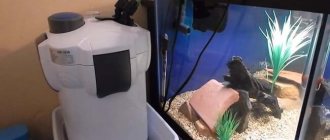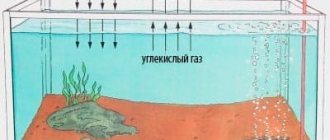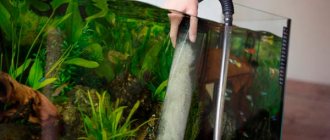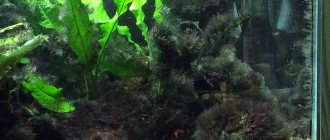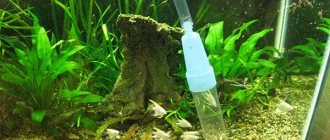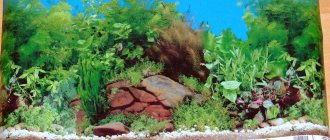Any aquarist should clearly understand that an aquarium is a very small artificial reservoir in which all processes occur instantly. Considering the fact that even experienced aquarists with experience manage to overpopulate their aquarium, without using a good external filter there can be no question of normal biological filtration in an aquarium. So, if you do not want your aquarium inhabitants to suffer from excess ammonia and nitrite, then I advise you to read this article to the end. From it you will learn about the design of external filters for an aquarium, the rules for choosing them, as well as some of the pros and cons of using them.
Types of water filtration
Mechanical filtration
The essence of mechanical filtration is that the filter mechanism purifies the water in the aquarium from small particles of mechanical suspension. By mechanical suspension in an aquarium we usually mean food residues, fish feces and other mechanical particles that are present to one degree or another in the water poured into the aquarium. Mechanical filters are usually suitable for small aquariums up to 70 liters. The design of such filters is usually simple: a motor and a sponge. Aquarium water, passing through a sponge, is cleared of various types of suspensions.
Chemical filtration
The essence of chemical filtration of aquarium water is that the water is purified at a chemical level using an absorbent. The most striking and simple example of a filter media that performs the function of chemical filtration is the well-known carbon. Zeolite is also very popular. Various absorbents that are used in chemical filtration are capable of removing the three most harmful substances present in varying concentrations in any aquarium - ammonia, nitrite and nitrate.
Biological filtration
Every aquarist must know what biobalance is in an aquarium and what biological filtration is. After all, this is the most important and desired type of filtration by every aquarist. The essence of biological filtration is that water purification in an aquarium is carried out by living organisms - nitrifying aerobic bacteria - which settle in the biological filter filler. These bacteria decompose harmful ammonia into nitrite, and then the resulting nitrite into nitrate, which is used for growth by aquarium plants. Porous materials, most often ceramics, are used as a filler for a biological filter.
Combined filtration
Combined filtration involves simultaneous purification of aquarium water at the biological, chemical and mechanical level.
Since biological filtration is a priority for any aquarist, this article will further discuss external filters for the aquarium, since they best cope with this role.
What can replace the cleaner?
An aquarium filter cannot be replaced by anything , since only specially manufactured devices are capable of efficiently purifying water and keeping a closed system in biological balance.
There are many instructions on the Internet for making external and internal filters with your own hands, but such a device is not capable of 100% high-quality and, most importantly, safe continuous cleaning of aquarium water.
The only alternative to a filter is to arrange the aquarium in such a way that the system itself can process harmful substances and prevent their accumulation. With a properly created biological balance, the inhabitants of the tank can live a long life without a filter. It is only necessary to change some of the water in a timely manner.
The main nuances that will allow you to keep an aquarium without a filter for as long as possible:
A large number of plants. An ideal option would be elodea, fern, vallisneria, echinodorus, various mosses and ferns.- After planting plants in the ground, you need to wait time (about 2-3 weeks) for the biological balance to appear, only then you can add fish.
- There should not be many inhabitants; overpopulation should not be allowed.
- Change 10% of the water once a week and siphon the soil.
- It is necessary to add crustaceans to the container, which naturally purify the water, as well as aquarium orderlies (shrimps, snails, ancistrus).
- Do not allow uneaten food to remain after feeding.
If the aquarium filter is suddenly turned off, everything must be done to preserve the life and health of the tank’s inhabitants. You should not deliberately turn off the filter too often, even for a short time : the device is designed for continuous operation, and frequent shutdowns lead to rapid breakdown.
- Related Posts
- How to choose and care for a sponge for an aquarium filter?
- Top 6 best external and internal filters for a 300 liter aquarium
- What kind of filter is needed for a 100 liter aquarium? Rating of the best external and internal models
Discussion: there is 1 comment
- Varvara:
07/04/2019 at 11:58Hello, my electricity went out for 4 hours. Did this cause much discomfort? (There are only ancistrus in the aquarium). If someone doesn’t understand, then they turned off the filter and the light
Answer
Advantages of an external filter for an aquarium
1. Large area of material for filtration. This allows for the maximum level of biological filtration due to the large number of aerobic nitrifying bacteria that settle on the sponge.
2. Combined filtration. The external filter bucket allows you to accommodate various absorbent and filter materials, which turns the filter into a combination filter.
3. They do not reduce the volume of water in the aquarium, but, on the contrary, increase it. The external filter hoses and the filter bucket itself contain a certain volume of water, which is added to the total volume of water in the aquarium.
4. Shorter service life. External filters need to be cleaned less often, and this is much easier to do because you don’t have to reach into the aquarium with your hand.
5. Long service life (from two to eight years).
What happens if you turn it off often?
When the filter is turned off, organic waste from fish and uneaten food begin to rot, releasing toxic compounds into the water.
At the same time, without air entering the filter, nitrifying bacteria die , which neutralize the decay products of organic substances in the water.
After turning on the filter, the entire mass of dead bacteria is released into the water, polluting it even more. The colony of nitrifying bacteria is restored slowly.
In an overcrowded aquarium with no living plants, turning off the filter for a long time means poisoning the inhabitants of the home pond.
An aquarium in which:
- Unpretentious fish live . Ancistrus, gouramis, neons and guppies can easily survive for some time without water treatment.
- There is a small population . The fewer inhabitants, the less organic waste ends up in the water. Experienced aquarists advise populating the container according to the following scheme: per 1 cm of body length of an adult, there should be at least 1 liter of water.
- A lot of plants . Plants are able to absorb organic compounds, and they also enrich the water with oxygen. Plants in large numbers can temporarily take over the function of maintaining cleanliness.
Only if the conditions described above are met, periodic short-term switching off of the filter will not be too critical for the aquarium.
When should you start thinking about buying an external filter for your aquarium?
Of course, you can use an external filter for 60 liter jars (just remember to take care that the fish are not sucked into the filter hose), but it is recommended to use external filters in aquariums of 200 liters or more. For 60 liter cans, the use of an external filter is recommended for overcrowding.
When purchasing an external filter for an aquarium, be sure to pay attention to the manufacturer’s recommendations regarding the volume of the aquarium for which the filter is intended. Considering the fact that modern external filters have many additional functions, such as water heating and aeration, an ultraviolet nozzle, you should not save on purchasing an external filter for an aquarium.
Direct
External filter fillers for aquarium
As a rule, the soup kit for an external aquarium filter includes the following filter materials:
1. Foam rubber or synthetic winterizer (possibly two materials at once)
2. Ceramics
3. Zeolite or coal
4. Peat
It should be remembered that it is recommended to use charcoal only at the start-up stage of the aquarium, since over time it loses its absorbent properties. After a month and a half, you should replace the compartment with coal with ceramics or foam rubber.
How to make a filter for an aquarium with your own hands?
It is not always possible to purchase a branded water purifier, but you can make your own. To make a filter you will need:
- A round small plastic tank or bottle.
- Bendable hoses.
- Three flowerpots.
- Electric pump. The power is selected depending on the volume of the aquarium.
- Sintepon or foam rubber.
- Two fittings with valve.
- Filler of your choice, preferably carbon or ceramic.
It’s easy to make an aquarium filter with your own hands, the main thing is to follow the manufacturing sequence:
- A hole must be made in the bottom of the canister, and a fitting is inserted into the resulting hole. Two slots are made in the lid: the first for the valve, the second for the electric pump.
- The pump must be connected to the structure from the inside; the joints must be carefully coated with silicone gel.
- Next, you need to make filter cassettes - they are made from flower pots. Half of each flowerpot is cut off and small round holes are made in the bottom. All three pots need to be filled with filter materials: the first with synthetic padding, the second with coal, the third with foam rubber.
- The pipes must be fixed to the inlet and outlet valves. Before attaching the hoses, you need to measure their length, otherwise they may not fit the tank. The hose attachment points are coated with silicone to prevent liquid from getting into the opening between the joints and the canister or the hoses falling out. The filter is ready.
- The tank, which is used as a housing for the filter, is filled with water and left for a day. If there are no leaks, then the device can be installed in the desired location and connected.
How to choose an external filter for an aquarium
When choosing and purchasing an external filter for an aquarium, you need to know what key points you should pay attention to.
1. If you are buying an external filter for an aquarium with a volume of up to 100 liters, then you should focus on the silent operation of the filter, since the external filter will cope with mechanical and biological filtration in any case.
2. For an aquarium up to 100 liters, the filter capacity should be approximately 300-500 liters per hour. This performance of an external aquarium filter will be enough even if your aquarium is overcrowded, which happens very often. Your choice is Aquael MINI KANI 80, Tetra EX 600 Plus, EHEIM Ecco Pro 130.
3. For an aquarium larger than 100 liters, the output of the external filter should be approximately 700 liters per hour. Your choice is Tetra EX 800 Plus, EHEIM Ecco Pro 200, Aquael MIDIKANI 800.
4. Potbelliness of the canister. The larger the volume of the canister, the larger the volume of filter material. In this case, the water will be cleaner and its flow more stable.
5. Number of trays. The greater the number of trays, the more the user of an external aquarium filter can experiment with different types of fillers. Give preference to filters that have at least three or four compartments for fillers.
6. Hose thickness. The rule here is that thicker is better than narrower. The fact is that over time, the inside of the hose becomes covered with a coating of algae and other suspended matter, which will impede the flow of water in the hose.
To summarize, we can say that when choosing an external filter, you should focus on three indicators: productivity (in liters per hour), power consumption (in watts) and the recommended aquarium volume (in liters).
When choosing an external filter for an aquarium with a particular pump power, do not forget to take into account the fact that the sponge takes 10% of the power, or even 20-25%, the remaining 30-50% of the power will be taken by the rise of water into the aquarium if the filter is installed under an aquarium in a cabinet.
What types of aquarium filters are there?
Each aquarist chooses a water purifier that is suitable specifically for his tank. There are three main criteria by which they can be divided:
- by type of filtration;
- by installation method;
- on the filter element.
By filtration type
They are divided into:
- Mechanical filters are suitable for small aquariums. They are equipped with a pump that pumps water inside, where it passes through an absorbent sponge that traps dirt. In this way, large contaminants are removed. On top of the pump there is a tube to release filtered water back into the reservoir.
- Chemical ones purify water through absorbents (the most popular is activated carbon). Absorb harmful impurities. If you do not replace the substance with a new one in time, everything that you have absorbed may be thrown back into the tank.
- Biofilters (biological) are based on breeding special bacteria in an aquarium that live on a specific substrate (for example, unfired ceramics). With their help, organic waste that releases toxic substances is processed into less dangerous nitrites, and then into nitrates.
- Combined filters combine several types of filtration into one. For example, coal is added to the mechanical one, and the purification takes place in several stages (through a sponge, then through a substance).
By installation method
There are internal and external.
The first are divided into:
- Air: A sponge filter consists of a plastic tube that extends to the surface and supplies air to the reservoir, and is also attached to the end of the sponge. When air is supplied, water is sucked in and passes through the cleaning element. It is attached to the wall with suction cups.
- Bottom is rarely found in everyday life; it is usually used in conjunction with other species. It is attached to the bottom of the aquarium and covered with soil on top, which acts as a cleaner. Consists of plastic pipes and performs bioremediation. Does not allow the substrate to sour. There is a risk of hydrogen sulfide or methane bubbles.
- The mounted one is suitable for small and medium-sized aquariums and combines several types of cleaning. It is attached with suction cups to the wall of the tank so that two thirds are under water. The liquid is dissected as it exits, which avoids strong flow.
External ones include canister and irrigated. In the first case, the container is placed outside, two tubes are inserted into the reservoir to capture dirty water and supply clean water. Provides all types of filtration. Additionally, it is equipped with heating and disinfection using ultraviolet light.
In irrigated areas, bioremediation is used. Inside the vessel there are special bio-balls on which bacteria are located. As water passes through, they clean it and release it back. Suitable for professional aquarists only.
By filter element type
Cleaning materials are divided into mechanical and biological. The first include sponges and absorbents. The second includes bacteria and peat. Sponges are the most common cleaning element and are present in many types of aqua filters. Small and large pores trap dirt and the water comes out clean. During the cleansing process, bacteria appear on them, which contribute to the transformation of toxic substances. The sponge should be washed once every two weeks.
Activated carbon is rarely used. It cleans better than a sponge, but it needs to be changed constantly. If it is not replaced in a timely manner, it may burst and throw everything that has accumulated back into the water. This will lead to the death of the inhabitants.
To breed nitrite bacteria, biological multiporous ceramics are used. Colonies quickly form on it, and cleaning is more efficient. Best in tandem with a mechanical cleaner.
Granulated peat is used to create the effect of natural conditions and weak oxidation of water.
Cleaning the external aquarium filter
Cleaning the external filter involves washing the filter materials (ceramics, foam rubber) or replacing them (zeolite, carbon), as well as cleaning the mechanical parts of the filter.
The procedure for cleaning the external filter for an aquarium is as follows.
1. You must first visit the store and buy heavily worn filter material (sponges, padding polyester, peat).
2. Turn off the external filter from the power supply.
3. Shut off and disconnect the hoses.
4. Place the external filter in the basin, remove the lid and drain all the water
5. We take out the fillers and clean them or replace them if necessary
6. Open the rotor chamber and thoroughly clean the rotor of organic matter
7. Assembling the filter. Don’t forget to fill the external filter canister with water before turning it on.
How to correctly arrange filter materials in an external filter
When filling filter baskets with filtration materials, you need to follow a simple rule. The essence of this rule is that before biological treatment, water must undergo mechanical treatment.
In practice, this means the following: if the water flow in the filter goes from bottom to top, then there should be a sponge at the bottom, then ceramics or sintered glass should go, and at the very top you can place a padding polyester for maximum purification of water from suspended matter.
In my filter, for example, I use only a standard sponge and sintered glass filler, excluding padding polyester altogether (the water is already clear).
Prefilter What is it and is it needed at all?
In the vast majority of cases, the suction tube of the external filter does not have a sponge on it. To prevent the suction of fish fry and large particles of dirt, manufacturers use various mechanisms such as a check valve (for example, in my external device, the manufacturer uses a ball, which 1) narrows the opening for water intake and 2) blocks the flow of water in the absence of suction towards the filter basket).
Whether to put a sponge on the suction tube or not is up to everyone to decide for themselves. This sponge on the inlet hose is called a prefilter. When using a prefilter, two problems are solved: 1) the fry is prevented from getting inside the outer; 2) water entering the filter undergoes additional mechanical cleaning.
Tips for choosing
The design of internal aquarium filters is so simple that even a beginner can easily figure it out. This is a cylindrical plastic body with special holes for drawing in water. Inside the housing there are sections where the filter elements are located. Typically used:
- special modules (ultraviolet, ceramic);
- biological sponges;
- filler (mainly activated carbon).
When the pump operates, water from the container is drawn into the filter and then passes through a stepwise cleaning system. The purified water is then returned back to the aquarium. On the market you can find more expensive analogues of filters that have additional functions, for example, a heating element, pump power.
When choosing, you need to take into account various factors:
- number of aquatic inhabitants;
- feeding frequency;
- presence and number of plants (both real and artificial).
Model performance is also important. It is desirable that it be at least 5-7 volumes. For a hundred-liter tank, options are selected that pump at least five hundred liters per hour. It is not recommended to choose devices that are too small, since small dimensions negatively affect the amount of filter material.
Brush for cleaning external filter hoses
Over time, the external filter hoses become overgrown with algae. In addition to the fact that it looks unaesthetic, during the first cleaning you will be faced with the problem that plaque damaged by bending the hoses during cleaning will fall directly into the aquarium. But this is a solvable problem.
There are special brushes for cleaning hoses that can be purchased at a pet store. Such brushes usually have bristly fibers at both ends. The very basis of such a brush is a metal cable, reminiscent of the one used to clean clogged pipelines in the bathroom.
The best external filters for an aquarium
Tetra EX Plus
The filter from this manufacturer exists in three modifications: Tetra EX 600 Plus (60-120 liters), Tetra EX 800 Plus (100-300 liters), Tetra EX 1200 Plus (250-500 liters).
Tetra EX 600 Plus can be used in aquariums starting from 60 liters, but not exceeding 120 liters. The filter has five different media (water passes through ceramic rings, bio-balls, traditional sponge, carbon media and fiber pad, which remove various dirt particles and provide biological, mechanical and chemical filtration). Filter elements are changed in accordance with the manufacturer's recommendations once every 6-12 months. You can purchase this filter for a price ranging from 5,000 to 7,000 thousand rubles.
SERAfil BIOACTIVE
The filter from this manufacturer exists in three modifications: SERAfil BIOACTIVE 130 (up to 130 liters), SERAfil BIOACTIVE 250 (up to 250 liters), SERAfil BIOACTIVE 400 (up to 400 liters).
The cost of the external filter SERAfil BIOACTIVE 130 ranges from 4,000 to 7,000 thousand rubles.
EHEIM IS THE PERMANENT LEADER IN THE MARKET OF EXTERNAL FILTERS
The filter from this manufacturer exists in three modifications: EHEIM Ecco Pro 130 (60-130 liters), EHEIM Ecco Pro 200 (100-200 liters), EHEIM Ecco Pro 300 (160-300 liters).
EHEIM filters are rightfully considered among aquarists to be the best external filters. These filters combine low energy consumption with high performance, provide excellent mechanical and biological filtration, and operate very quietly. The EHEIM Ecco Pro 130 filter costs around 6,000 - 8,000 thousand rubles.
A very good review of the EHEIM brand external aquarium filter can be found on the website at https://zoo-forum.com.ua/post1266.html.
AQUAEL IS GRADUALLY COMING TO THE LEADERS OF EXTERNAL FILTERS
The filter from this manufacturer exists in three tested and proven modifications: MINIKANI 80 (up to 80 liters), MINIKANI 120 (80-120 liters), MIDIKANI 800 (120-250 liters), MULTIKANI (20-320 liters).
The MINIKANI 80 filter has a compact high-performance remote pump, is an alternative to internal filters for small-volume aquariums, and is simple and easy to install and maintain. The cost of MINIKANI 80 on the Russian market is about 4000 - 5000 thousand rubles.
JBL IS A VERY POPULAR FILTER BRAND IN THE RUSSIAN MARKET
The filter from this manufacturer exists in three modifications: JBL CristalProfi e401 greenline (40-120 liters), JBL CristalProfi e701 greenline (60-200 liters), JBL CristalProfi e901 greenline (90-300 liters).
External filters from JBL are characterized by very quiet operation with a pump capacity of 450 liters per hour. A distinctive feature of JBL filters is the patented pre-filter: high-performance biofilter with a volume of 4.6 liters, shut-off valve, hose connection with the ability to rotate 360°, easily replaceable filter materials.
The cost of the JBL CristalProfi e401 greenline model ranges from 6,000 to 7,000 Russian rubles.
SICCE - ITALIAN MANUFACTURER OF EXTERNAL FILTERS
The filter from this manufacturer exists in three modifications: Sicce SPACE EKO+ 100 (up to 100 liters), Sicce SPACE EKO+ 200 (up to 200 liters), Sicce SPACE EKO+ 300 (up to 300 liters).
The cost of Sicce SPACE EKO+ 100 fluctuates around 4000 - 4500 Russian rubles.
The line of filters from the Italian manufacturer SICCE, which has proven itself well in Europe, also includes models of external filters of the WHALE series. This series differs from the SPACE EKO+ series in higher cost, quieter operation of the filter and more durable glossy material for the filter canister.
Sicce SPACE EKO+ filters have a unique filter design, unlike any other manufacturer. There is a knob for adjusting the power of water flow, a pump for quick start of the filter. I use this filter model in my 60 liter aquarium, so if you have questions about this brand of external filter, write in the comments, I will answer everyone.
Did you like the article? Not good? Then it is possible that you will write yours much better. Just follow the link Posting articles and read the rules for publishing articles on the MultiBlog67.RU website.
What is it for and how does it work
The main purpose of the internal aquarium filter is to purify and enrich the water with oxygen to improve the living environment of the aquarium inhabitants. So we can say unequivocally: yes, a filter is needed.
Such a device is a small cylinder with side holes for suction of water with a pump attached to it. The housing contains one or more filters. In the simplest version, the filter element is foam rubber. Water under pressure, passing through the porous structure of the foam rubber, leaves all the debris in the cells and returns back to the aquarium.
Saprophytic bacteria accumulate in the foam rubber; colonies of these microorganisms purify the water in the aquarium from organic waste, turning them into inorganic substances. The device resembles a glass in appearance. Aquarists often call it that.
Important! It is better to choose a filter with a capacity of 3-5 volumes of your aquarium per hour. That is, if you have a 100 liter aquarium, look for a device with a capacity of at least 300 liters, and preferably 500 liters per hour.


